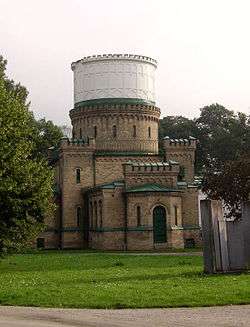Lund Observatory
Lund Observatory is the official English name for the astronomy department at Lund University. As of January 2010, Lund Observatory is part of the Department of Astronomy and Theoretical Physics at Lund University. It is located in Lund, Sweden.
 A historic building of the old Lund Observatory, inaugurated in 1867 | |
| Organization | University of Lund |
|---|---|
| Observatory code | 039 |
| Location | Lund, Sweden |
| Coordinates | 55.699580°N 13.187850°E |
| Established | 1749 |
| Website | www |
 Location of Lund Observatory | |
The institution was founded in 1749, but was preceded by an observatory built by astronomy professor Anders Spole (the grandfather of Anders Celsius) in 1672, which was destroyed at the Battle of Lund in 1676. The now old observatory from 1867 is located in a cultural-heritage protected observatory park just outside the medieval city boundaries. The current Lund Observatory location is in a new building on the northern campus of Lund University, inaugurated in 2001. The history of astronomy in Lund through five centuries is told in the book Lundaögon mot stjärnorna[1]
Today Lund Observatory research activity focuses on observational and theoretical astrophysics. Areas covered include galaxy formation and evolution, exoplanet research, laboratory astrophysics, high-energy astrophysics, star clusters, and astrometry (Hipparcos and Gaia).
The Lund Panorama of the Milky Way
Towards the middle 20th century astronomer professor Knut Lundmark, of the Lund Observatory in Sweden, supervised the two engineers Martin Kesküla and Tatjana Kesküla who painstakingly mapped the positions of about 7000 individual stars to create an unprecedented drawing of the Milky Way. The map took two years to complete (it was completed in 1955), measures 2 m (6.6 ft) by 1 m (3.3 ft), and is known as the Lund Panorama of the Milky Way.[2]
References
- Lindegren, Lennart (2003). Lundaögon mot stjärnorna. Lund: Lunds universitetshistoriska sällskap. p. 268. ISBN 91-631-3446-2.
- "Lund Panorama of the Milky Way". Archived from the original on 2011-01-29.